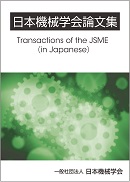Volume 86, Issue 881
Displaying 1-25 of 25 articles from this issue
- |<
- <
- 1
- >
- >|
Solid Mechanics and Materials Engineering
-
2020Volume 86Issue 881 Pages 19-00203
Published: 2020
Released on J-STAGE: January 25, 2020
Advance online publication: December 20, 2019Download PDF (2035K) -
2020Volume 86Issue 881 Pages 19-00318
Published: 2020
Released on J-STAGE: January 25, 2020
Advance online publication: December 23, 2019Download PDF (2831K)
Fluids Engineering
-
2020Volume 86Issue 881 Pages 19-00336
Published: 2020
Released on J-STAGE: January 25, 2020
Advance online publication: January 10, 2020Download PDF (8088K) -
2020Volume 86Issue 881 Pages 19-00342
Published: 2020
Released on J-STAGE: January 25, 2020
Advance online publication: December 27, 2019Download PDF (2175K) -
2020Volume 86Issue 881 Pages 19-00355
Published: 2020
Released on J-STAGE: January 25, 2020
Advance online publication: December 27, 2019Download PDF (2328K)
Dynamics & Control, Robotics & Mechatronics
-
2020Volume 86Issue 881 Pages 18-00429
Published: 2020
Released on J-STAGE: January 25, 2020
Advance online publication: December 20, 2019Download PDF (4478K) -
2020Volume 86Issue 881 Pages 19-00163
Published: 2020
Released on J-STAGE: January 25, 2020
Advance online publication: December 26, 2019Download PDF (2011K) -
2020Volume 86Issue 881 Pages 19-00172
Published: 2020
Released on J-STAGE: January 25, 2020
Advance online publication: December 26, 2019Download PDF (1604K) -
2020Volume 86Issue 881 Pages 19-00173
Published: 2020
Released on J-STAGE: January 25, 2020
Advance online publication: December 20, 2019Download PDF (1568K) -
2020Volume 86Issue 881 Pages 19-00234
Published: 2020
Released on J-STAGE: January 25, 2020
Advance online publication: December 26, 2019Download PDF (1264K) -
2020Volume 86Issue 881 Pages 19-00237
Published: 2020
Released on J-STAGE: January 25, 2020
Advance online publication: December 26, 2019Download PDF (1814K) -
2020Volume 86Issue 881 Pages 19-00251
Published: 2020
Released on J-STAGE: January 25, 2020
Advance online publication: December 26, 2019Download PDF (10715K) -
2020Volume 86Issue 881 Pages 19-00303
Published: 2020
Released on J-STAGE: January 25, 2020
Advance online publication: December 20, 2019Download PDF (3069K)
Computational Mechanics
-
2020Volume 86Issue 881 Pages 19-00256
Published: 2020
Released on J-STAGE: January 25, 2020
Advance online publication: December 26, 2019Download PDF (2198K) -
2020Volume 86Issue 881 Pages 19-00343
Published: 2020
Released on J-STAGE: January 25, 2020
Advance online publication: December 20, 2019Download PDF (10566K)
Design, Machine Element & Tribology, Information & Intelligent Technology, Manufacturing, and Systems
-
2020Volume 86Issue 881 Pages 19-00080
Published: 2020
Released on J-STAGE: January 25, 2020
Advance online publication: December 16, 2019Download PDF (1592K) -
2020Volume 86Issue 881 Pages 19-00205
Published: 2020
Released on J-STAGE: January 25, 2020
Advance online publication: December 12, 2019Download PDF (1337K) -
Investigating the influences of coatings on the built-up layer formation during cutting of Ti-6Al-4V2020Volume 86Issue 881 Pages 19-00229
Published: 2020
Released on J-STAGE: January 25, 2020
Advance online publication: December 27, 2019Download PDF (3486K) -
2020Volume 86Issue 881 Pages 19-00397
Published: 2020
Released on J-STAGE: January 25, 2020
Advance online publication: December 13, 2019Download PDF (2029K)
Bio, Medical, Sports and Human Engineering
-
2020Volume 86Issue 881 Pages 19-00326
Published: 2020
Released on J-STAGE: January 25, 2020
Advance online publication: January 10, 2020Download PDF (1930K)
Transportation and Logistics
-
2020Volume 86Issue 881 Pages 19-00036
Published: 2020
Released on J-STAGE: January 25, 2020
Advance online publication: December 16, 2019Download PDF (1730K) -
2020Volume 86Issue 881 Pages 19-00249
Published: 2020
Released on J-STAGE: January 25, 2020
Advance online publication: December 26, 2019Download PDF (1764K) -
2020Volume 86Issue 881 Pages 19-00281
Published: 2020
Released on J-STAGE: January 25, 2020
Advance online publication: December 16, 2019Download PDF (1844K) -
2020Volume 86Issue 881 Pages 19-00295
Published: 2020
Released on J-STAGE: January 25, 2020
Advance online publication: December 16, 2019Download PDF (2085K) -
2020Volume 86Issue 881 Pages 19-00407
Published: 2020
Released on J-STAGE: January 25, 2020
Advance online publication: December 26, 2019Download PDF (1525K)
- |<
- <
- 1
- >
- >|
